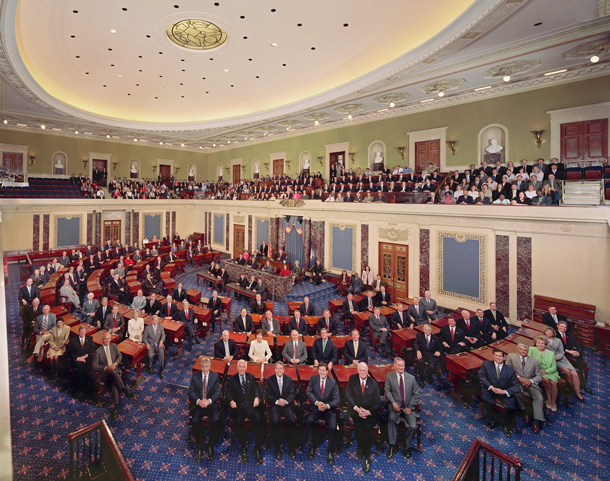The simple answer is “No.” Throughout the last century or so, we’ve seen many fights in the U.S. Senate take place in which a “filibuster” and/or “cloture” vote were significant, AND very controversial. Have you ever wondered where and how this process began? As important as it has been in the presidency, I think it’s important for each American to understand. Let’s take a history lesson together.
The term filibuster — from a Dutch word meaning “pirate” — became popular in the 1850s, when it was applied to efforts to hold the Senate floor in order to prevent a vote on a bill. In the early years of Congress, representatives as well as senators could filibuster. As the House of Representatives grew in numbers, however, revisions to the House rules limited debate. In the smaller Senate, unlimited debate continued on the grounds that any senator should have the right to speak as long as necessary on any issue. In 1841, when the Democratic minority hoped to block a bank bill promoted by Kentucky Senator Henry Clay, he threatened to change Senate rules to allow the majority to close debate. Missouri Senator Thomas Hart Benton rebuked Clay for trying to stifle the Senate’s right to unlimited debate. Three quarters of a century later, in 1917, senators adopted a rule (Rule 22), at the urging of President Woodrow Wilson, that allowed the Senate to end a debate with a two-thirds majority vote, a device known as “cloture.” The new Senate rule was first put to the test in 1919, when the Senate invoked cloture to end a filibuster against the Treaty of Versailles. Even with the new cloture rule, filibusters remained an effective means to block legislation, since a two-thirds vote is difficult to obtain. Over the next five decades, the Senate occasionally tried to invoke cloture, but usually failed to gain the necessary two-thirds vote. Filibusters were particularly useful to Southern senators who sought to block civil rights legislation, including anti-lynching legislation, until cloture was invoked after a 60 day filibuster against the Civil Right Act of 1964. In 1975, the Senate reduced the number of votes required for cloture from two-thirds to three-fifths, or 60 of the current one hundred senators.
Many Americans are familiar with the filibuster conducted by Jimmy Stewart, playing Senator Jefferson Smith in Frank Capra’s film Mr. Smith Goes to Washington, but there have been some famous filibusters in the real-life Senate as well. During the 1930s, Senator Huey P. Long effectively used the filibuster against bills that he thought favored the rich over the poor. The Louisiana senator frustrated his colleagues while entertaining spectators with his recitations of Shakespeare and his reading of recipes for “pot-likkers.” Long once held the Senate floor for 15 hours. The record for the longest individual speech goes to South Carolina’s J. Strom Thurmond who filibustered for 24 hours and 18 minutes against the Civil Rights Act of 1957.
So who decides how many votes it takes to pass legislation or take other actions in the House and Senate? I have always assumed those rules were set in the Constitution. However, here’s what the Constitution says about that matter in Article I, section 5: “Each House shall be the Judge of the Elections, Returns and Qualifications of its own Members, and a Majority of each shall constitute a Quorum to do Business; but a smaller Number may adjourn from day to day, and may be authorized to compel the Attendance of absent Members, in such Manner, and under such Penalties as each House may provide. Each House may determine the Rules of its Proceedings, punish its Members for disorderly Behaviour, and, with the Concurrence of two thirds, expel a Member.”
“Each House may determine the Rules of its Proceedings….” is the Constitutional phrase — the ONLY one — that sets rules for operating either Chamber. That’s exactly what the Senate did as described above where is says: “the Senate reduced the number of votes required for cloture from two-thirds to three-fifths, or 60 of the current one hundred senators.” The Senate decided that — not the Constitution! So why the heck cannot or will not the Senate change that stupid rule to 50 to pass legislation?
Some will respond that “the Senate’s business is too important to make it so easy as to implement, repeal, and change laws that were passed before.” To that my response is a direct quote from the Chicago Constitutional lawyer that in January checked out of the White House Hotel in D.C.: “Elections have consequences.” How stupid is it to think that the President who is duly elected by the people cannot sign into law any legislation that the majority members of the House of Representatives and the Senate passed and in unity crafted a bill and sent to him? After all, the majority of the American people voted for this president, this Senate, this House of Representatives. Do those duly elected people not have the authority to conduct the very activities for which they were elected to do by the American people?
This is Insane!
So what’s the answer? Rollback that stupid “60-vote” requirement that has been in place since 1975. Make it a majority with — as the Constitution states — the Vice President as the President of the Senate casting a deciding vote in the case of ties. Let the People have the bills passed that their duly elected representatives in Congress passed go to the President to be signed into law.
There are those who will say to that, “We cannot make it too easy to get laws terminated and new and different ones put in place to replace those, because in the next election, the majority could change and they could do the same thing, overturning laws just enacted.” My response to that is, “So what?” Isn’t our republic built to change as the People choose for it to change? Isn’t that why we have elections? Isn’t that why the majority rules? That’s exactly how Democracy works: “Of the People, By the People, and For the People.” Though President Obama when he declared that “elections have consequences” was not endorsing my opinion but rather rubbing his second White House victory in Republicans’ faces, what he said is demonstratively true. Elections that change the majorities in both Houses of Congress is the way it is supposed to happen in total disregard to how soon after the past Party change the most recent one happened. “Majority Rules.”
What to Do
Mitch McConnell should on Monday initiate the parliamentary process to amend the rules of the Senate, motion to change the Senate rule that requires a three-fifths majority for any legislative action to be going forward to a simple majority….period.
Senator McConnell, I know a few people in Kentucky that have voted for you many times and have supported you in many ways that are very upset that under your leadership, this current environment of “getting nothing passed or done” in the Senate is out of hand and must be fixed. We still need to get Healthcare finance revised and back in a fiduciary responsible process, tackle not just tax cuts, but tax reform, a plausible and financially sound infrastructure long-term plan, and for once and for all get the immigration debacle we face under control that includes REAL immigration process restructuring.
Senator, we CAN get this accomplished and accomplished quickly. Please put the partisanship, quid pro quo, and political correctness to the side and do what all of you in the G.O.P. promised Americans you would if you were sent back to D.C.
To quote Larry the Cable Guy, “Get ‘er Done!!!”


